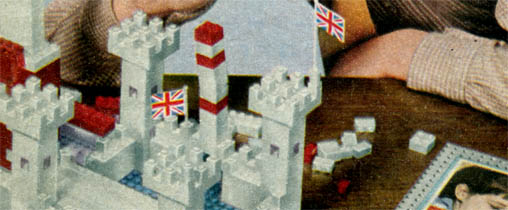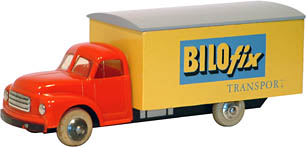Bilofix
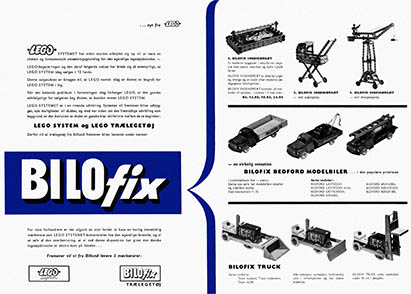
Bilofix retailer catalog, 1959
The plastic toys were quite successful for Lego. Dramatic spikes in sales occured in 1952 and again in 1955 with the introduction of the System i Leg. As the Lego system became more popular, and as more foreign markets were opened, Lego scaled back the non-brick plastic toys.1 1. The wood toys were only sold in Denmark and, to a lesser extant, in Norway. The non-system plastic toys were only sold in Denmark, Norway and Sweden. Starting with Germany in 1956 all new foreign markets were only offered the Lego System. By 1958 the Lego System was the only plastic toy sold by the company.
Sales of the wooden toys, which peaked in 1952, had remained relatively flat. By 1959 the plastic toys accounted for more than twice the revenue of the wooden toys.
The name Lego was now so closely associated with the Lego System, especially outside of Denmark, that Godtfred decided to split the company into two divisions. The plastic toys would be marketed under the name Lego System and the remaining wood toys under a new name: Bilofix (or, more specifically, BILOfix, from the Danish for “Billions of toys”). Gerhardt became the manager for the new division. Lego trademarked the name in Denmark on 18 July 1959.

The 1679 Selvbinder as a Lego toy and as a Bilofix toy
The Bilofix product range consisted of the remaining wooden designs simply rebranded with Bilofix decals, as well as several new plastic and wood designs, such as the Bilofix Transport truck and the Ingeniør sets.
This new division would last less than a year.
Futura
Lego’s product development had always been informal. It typically consisted of designing sets in Ole’s study or Godtfred’s den and testing them with Gunhild, Kjeld, Hanne or their cousins. But the rapid growth of the newly-created system meant that Godtfred needed a better and more formal development approach. In 1959 he created a product development group: Lego Futura.
Lego Futura started in Billund with five employees, including a product development manager. Initially they developed new ideas for parts and sets, however, over time their responsibility expanded to include not only product design but also longer-range strategic development, including new technologies, such as electronics and computers. The Futura group grew and new branches in were established in Boston (1989) and Tokyo (1991). By 1995 Futura had more than 240 employees.
British Lego Ltd.
In the 1950’s England was perhaps second only to Germany as a European toy market. Companies such as Airfix, Corgi, William Britain, and perhaps most importantly, Frank Hornby’s Meccano were already well-established. Lego could not simply set up their own sales company, as they had done in Germany, and Godtfred began looking for a licensing partner. In 1959 he licensed the Lego System to the Courtaulds Group.
Courtaulds was established in 1810 by George Courtauld as a silk and textile mill. In 1910 they opened the first commercially successful viscose rayon plant and over time became the largest producer of cellulose-based textiles (such as cellulose acetate) in the UK and by 1960 they had over 60,000 employees. They were so large that they could control all aspects of the textile business, from owning tree farms in South Africa, to producing the synthetic fibers, to manufacturing the finished clothing.2 2. Courtaulds became a major supplier of womens underwear and lingerie in Europe. In 2000 the textile division was acquired in a hostile takeover by Sara Lee and became Sara Lee Courtaulds. Today it is the leading supplier of lingerie to Marks and Spencer in the UK and Victoria’s Secret in the US. So Lego is at least obliquely related to lingerie, what else could you ask for? Maybe this?
After they were awarded the Lego license, Courtaulds set up British Lego Ltd. in London and began sales in 1960 with elements imported from Billund. It would be the first of several toy companies owned by the conglomerate.3 3. Courtaulds, through their subsidiary, British Celanese, purchased British Trix in Apr 1963 and G & R Wrenn in Jun 1964. It appears that all of these companies, including British Lego Ltd, shared board members. By 1962 British Lego Ltd was marketing sets in Australia, Ireland, as well as other British colonies.
In 1963 British Lego Ltd. set up a new headquarters and factory in Wrexham, Wales and all subsequent sets were manufactured in the UK. This license agreement lasted until 1993 when Lego set up their own sales organization, Lego UK Ltd.
Bilofix Transport
The Bilofix Transport Truck, one of the new Bilofix designs, consisted of both wood and plastic components. The wooden frame, wheels, cargo box and cover were typical of the current wooden toys. The molded plastic cab was the last non-brick plastic design produced by the company.
Bilofix Ingeniørsæt
The Ingeniørsæts (Engineer Sets), designed by Gerhardt to be a completely new educational construction system, consisted of clear birch beams and blocks and plastic nuts and bolts. It was very similar to several existing European toys such as Lorenz’s Baufix and Brio’s Bygg-Brio system. Three different sets (no. 1, 2 and 3) were first marketed in October 1959 and were available for less than a year. Gerhardt, however, would later resuscitate the product.
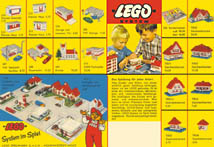
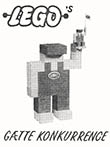
German Lego System catalog and Danish contest entry form, 1959

